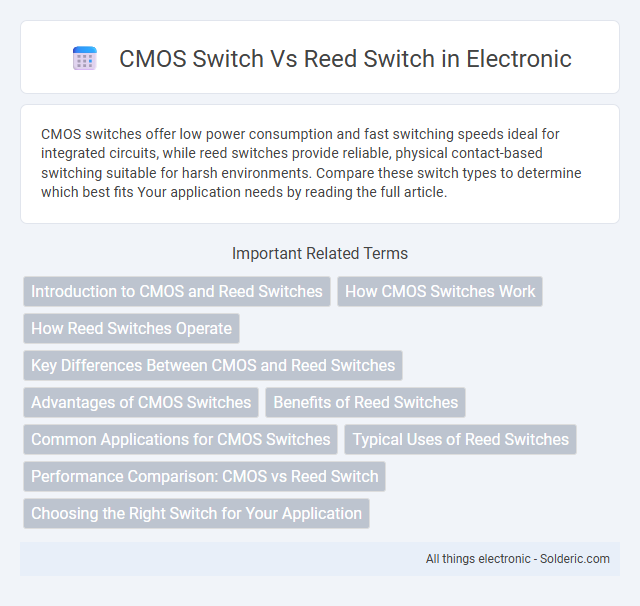CMOS switches offer low power consumption and fast switching speeds ideal for integrated circuits, while reed switches provide reliable, physical contact-based switching suitable for harsh environments. Compare these switch types to determine which best fits Your application needs by reading the full article.
Comparison Table
| Feature | CMOS Switch | Reed Switch |
|---|---|---|
| Type | Semiconductor-based switch | Magnetically operated mechanical switch |
| Operating Principle | Voltage-controlled MOSFET transistor | Magnetic field causes reed contact closure |
| Switching Speed | Very high (nanoseconds) | Moderate (milliseconds) |
| Contact Type | Solid-state (no mechanical parts) | Mechanical contacts (metal reeds) |
| Durability | High (millions of cycles) | Limited (typically 10^6 cycles) |
| Power Consumption | Low (static power) | None (passive device) |
| Size | Very small (IC compatible) | Small but larger than CMOS switch |
| Application | Analog multiplexers, signal routing | Magnetic sensing, security alarms |
| Voltage Rating | Typically low (up to tens of volts) | Higher voltage tolerance (up to 200V) |
| Noise | Low switching noise | Possible contact bounce noise |
Introduction to CMOS and Reed Switches
CMOS switches utilize complementary MOSFET technology to achieve low power consumption and high-speed switching in electronic circuits. Reed switches consist of two ferromagnetic blades sealed in a glass envelope, closing their contacts magnetically without electrical power. CMOS switches excel in integrated circuit applications requiring precise control, while reed switches are favored for their mechanical reliability and simplicity in sensing magnetic fields.
How CMOS Switches Work
CMOS switches operate using complementary pairs of metal-oxide-semiconductor field-effect transistors (MOSFETs) to control signal flow with low power consumption and high switching speed. These switches function by applying voltage to the gate terminal, which modulates the conductivity of the MOSFET channel, effectively turning the switch on or off. Unlike reed switches that rely on magnetic activation, CMOS switches offer precise electronic control suitable for integrated circuit applications and low-voltage environments.
How Reed Switches Operate
Reed switches operate by using two ferromagnetic blades sealed within a glass capsule, which close or open the circuit in response to an external magnetic field. When the magnetic field is applied, the reeds become magnetized, attracting each other to complete the electrical connection. Your choice between CMOS switches and reed switches depends on the need for contactless operation, as reed switches provide reliable, low-power switching without mechanical wear.
Key Differences Between CMOS and Reed Switches
CMOS switches utilize semiconductor technology, offering rapid switching speeds, low power consumption, and high integration capability, making them ideal for digital circuits. Reed switches are electromechanical devices with sealed metal contacts that respond to magnetic fields, providing high reliability and isolation but slower switching speeds. Key differences include CMOS switches relying on voltage control and semiconductor materials, while reed switches depend on magnetic actuation and mechanical contact closure.
Advantages of CMOS Switches
CMOS switches offer low power consumption and high-speed switching capabilities, making them ideal for efficient electronic circuit designs. Their compact silicon integration allows for greater miniaturization and reliability compared to reed switches, which rely on mechanical contacts. You benefit from enhanced durability and noise immunity with CMOS switches, ensuring consistent performance in sensitive applications.
Benefits of Reed Switches
Reed switches offer exceptional durability and reliability in harsh environments due to their hermetically sealed contacts, which protect against dust, moisture, and corrosion. Their ultra-low power consumption and fast switching capabilities make them ideal for battery-powered and sensitive electronic applications. Unlike CMOS switches, reed switches provide true galvanic isolation, ensuring minimal leakage current and enhanced signal integrity.
Common Applications for CMOS Switches
CMOS switches are widely used in applications requiring low power consumption and high switching speed, such as analog signal multiplexing, audio and video routing, and digital communication systems. They excel in precision instrumentation and sensor interfaces due to their minimal leakage current and excellent linearity. CMOS switches are also integral in battery-powered devices and portable electronics, where energy efficiency is critical.
Typical Uses of Reed Switches
Reed switches are commonly used in security systems, such as door and window sensors, due to their reliable open and close contacts triggered by magnetic fields. They are also found in proximity sensing applications, including position detection in industrial machinery and consumer electronics. Your choice of switch depends on factors like switching speed and power consumption, where reed switches excel in low-power, mechanically simple environments.
Performance Comparison: CMOS vs Reed Switch
CMOS switches offer faster switching speeds, lower power consumption, and higher integration capability compared to reed switches, which rely on mechanical contacts and tend to have slower response times and limited switching cycles. Reed switches exhibit excellent isolation and can handle higher voltage spikes, making them suitable for magnetic sensing and isolation applications, while CMOS switches excel in digital circuits requiring precise control and low on-resistance. Your choice depends on performance priorities: for speed and integration, CMOS switches outperform reed switches; for robustness and simple magnetic actuation, reed switches remain effective.
Choosing the Right Switch for Your Application
Selecting between CMOS switches and reed switches depends on your application's requirements for speed, power consumption, and durability. CMOS switches offer low power usage, fast switching speed, and high integration suitability for digital circuits, making them ideal for electronic devices needing precise signal control. Reed switches excel in reliability and isolation, functioning well in harsh environments with mechanical actuation, suitable for applications like security systems and sensors where physical contact triggers switching.
CMOS switch vs reed switch Infographic

 solderic.com
solderic.com